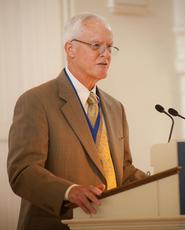
During this bicentennial year of Hamilton College, a unique and entertaining way of looking back at the college’s history is through the eyes of Half-Century class annalists. Their letters, invaluable in recording Hamilton’s past and recounting life on the Hill, have now been posted on a new web page. The five most recent are also available as videos.
The class annalist letter tradition began in 1865 when George Bristol prepared the first one for the Class of 1815. Since then an annalist has reminisced about classmates, the College and its faculty as they were in his undergraduate days 50 years earlier. The letters are read each year on Reunion Weekend to alumni gathered in the Chapel. They set the scene not only for what life was like on the Hill during the annalist’s time, but establish context for worldwide events as well.
The most recent annalist letter, by William D. Mattern ’61, spoke of the beginnings of the civil rights movement. “In March of 1960, the Student Senate at a special meeting decided to draft a letter to 50 colleges in the South and Northeast expressing ‘support for the peaceful demonstrations of Southern Negro students against segregated lunch counters,’ he wrote. “The next day, 46 Hamilton students picketed the F.W. Woolworth store in Utica to protest against the chain’s segregation policies in the South.
Mattern continued “We grew up in the calm between wars. We were too young to serve in the Korean War and too old to have our undergraduate education interrupted by the Vietnam War. Attending college was an ambition for many of us, and college was affordable. Total cost for us, including tuition, room and board, books and expenses, was about $2,000 a year.”
James B. Nickel ’52, who arrived with his class on the Hill in 1948, wrote of a time when freshmen acknowledged their place at the bottom of the pecking order. “When you were a raw freshman watching vets wearing leather flight jackets with American flags and Chinese writing on their backs, you learned your place in a hurry. You followed the rules, wore your pajamas and your beanie to the pep-rally bonfire and avoided walking on the grass. You were a freshman, the lowest being in the Mohawk Valley. Oh, we cut up a bit. We had won the Flag Rush and tug of war against the bored sophomores, and thus were entitled to wear red before the Union game in November. Wow. Flushed with success, we bravely trod the quadrangle grasses… bare-headed.
Later, we would further break with tradition by winning the Class Sing as freshmen. Our unruly behavior in South Dorm called for a verbal thrashing from Dean Tolles and editorial tut-tuts in The Spectator. Our behavior had been — well — sophomoric.”
Charles D. Root ’40 highlighted Hamilton’s attention to writing and speaking. “Our generation of Hamilton men got its inspiration for effective public speaking from three world-class speakers, Roosevelt, Churchill and ‘Swampy’ Marsh. I received more stories from my classmates about Swampy than about anyone else. I'm going to tell one. Wes Sprague says he will never forget Swampy emphasizing the importance of being clear, concise and deliberate when speaking. He underscored his point by booming out. ‘Remember, always stink dispeakly.’ Most of us hated Public Speaking, but today we generally feel that it was one of the most important courses we took at Hamilton.”
Richard A. Feleppa ’57 recalled The Honor Code as “an important part of our world. It trusted us — allowing us to take a break in the middle of an exam, leave the room or the building, go for a smoke or a coffee, even go to our dorm, and return to complete the test. It was that simple, a written pledge to seal a personal commitment of trust and obligation. It was only once or twice during our four years that a violation required that solemn announcement here in Chapel, ‘The Honor Court regrets to announce that this member of our student body be expelled from Hamilton College for fraud in an examination.’ The silence that followed said it all.”
